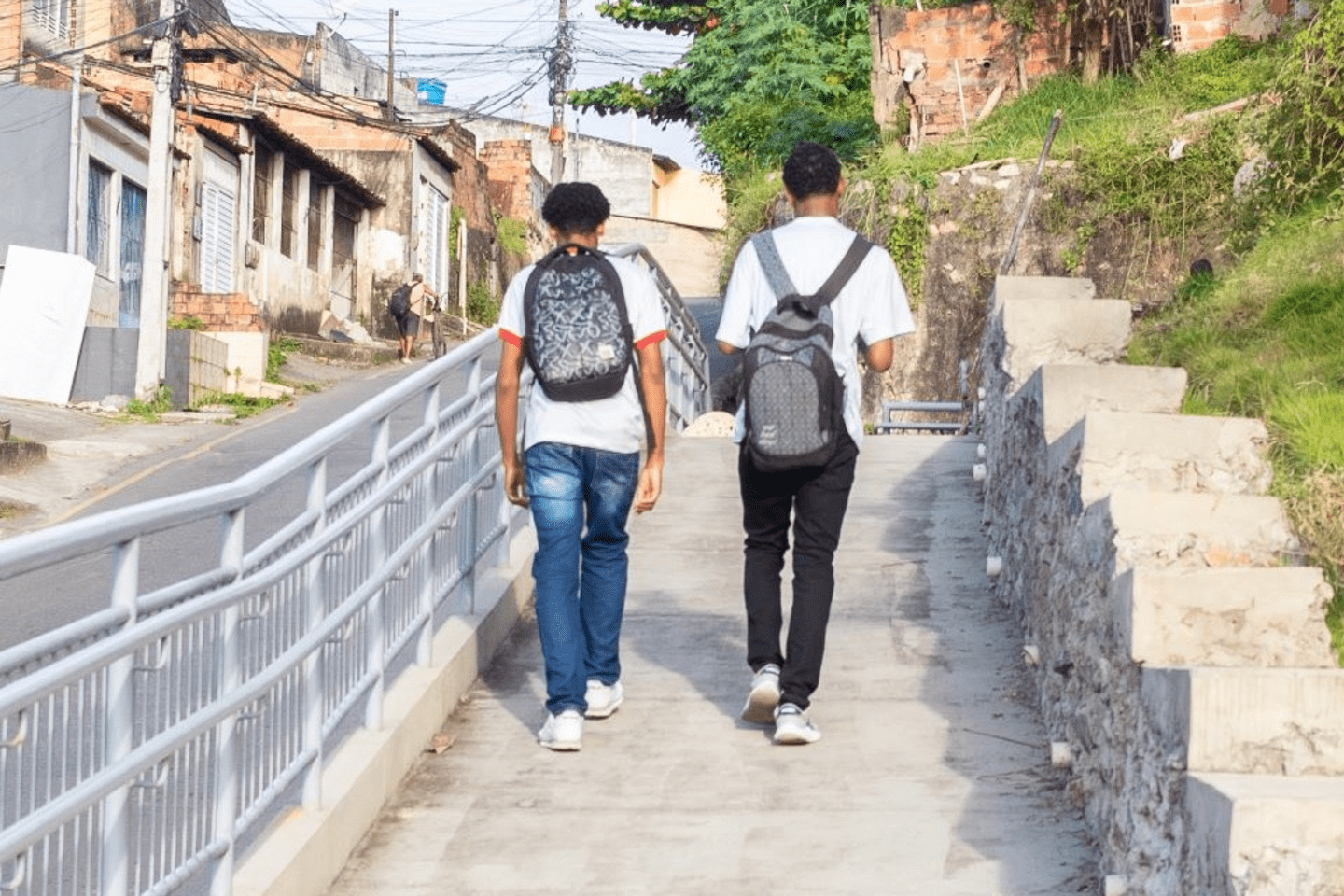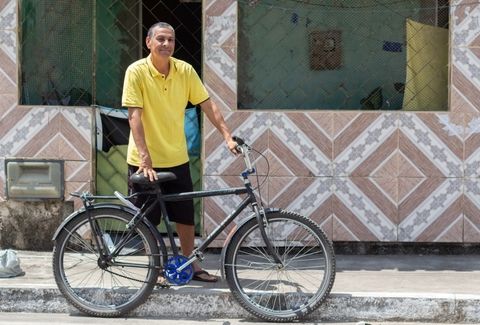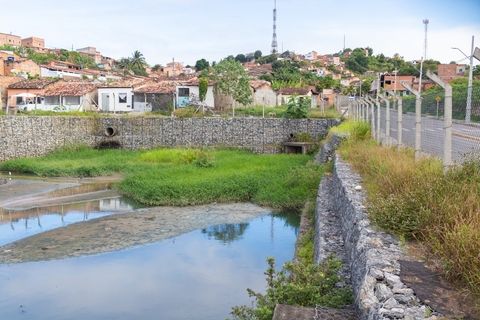
52 Brazilian cities strengthen their fiscal management, improving services and infrastructure for citizens.
The neighborhood known as Japãozinho, or “Little Japan,” is located in Aracaju, a city on the eastern coast of Brazil. According to the latest census, it has a population of 9,000 people. Aldo Lima Santos, 47, is one of those residents, but the neighborhood he has known all of his life is no longer the place it once was.
Under the shade of an almond tree, he describes a series of negative memories he has of the town, and one in particular: the floods.
“Several times, when I was still a boy, I would wake up at dawn to my parents crying out, ‘Wake up! Wake up!’, and I'd get off the bunk bed to find that the water was already waist-high,” Santos recalls. “The concern was always to get the children out of the water and to try and salvage anything in the house. Then, all that was left was praying to God that the rain would stop.”

Aldo Lima Santos is in front of his house holding his bicycle
Japãozinho has always been known for its high crime rate and its structural problems, such as open sewers and catastrophic flooding, which harried Santos’s family for years. But now, those events are mere memories.
In 2022, the Municipality of Aracaju paved 27 streets in Japãozinho, installed drainage and sewage systems, and built a 170-meter-long canal and two 4,000 m2 flood banks. In total, it was an investment in the urbanization of the neighborhood worth 17 million reais, or about $3.4 million. The investment also included new LED lighting, a staircase on the neighborhood’s main hill and pedestrian walkways and accessible paths. In a sense, Santos has new neighborhood.

Flood bank in Japãozinho
How a New Japãozinho Emerged
The construction work that has transformed Japãozinho was made possible through the Administrative and Fiscal Management Support Program for Municipalities (PNAFM). The project, which was developed 20 years ago by the Inter-American Development Bank (IDB) and is currently in its third phase, is helping municipalities like Aracaju modernize their fiscal management, thereby increasing their revenue and reducing unnecessary expenditures. That allows municipalities to have more resources to invest in improving public services and in infrastructure projects.
In the case of Aracaju, the project supported updates to the property value register, which is used as the basis for determining property taxes. The project also led to updated management systems for tax collection and employee trainings. As for public spending, the project financed the implementation of a new payroll system, as well as an update of the registry of active civil servants to reduce undue or unnecessary payments.
In sum, the PNAFM “has had a substantial impact on our tax collection and expenditure control, allowing us to have a better fiscal balance and making room for the municipality to access and make available other resources,” says Aracaju’s treasury secretary, Jeferson Passos.
Impacts Across Brazil
Currently, 52 municipalities in Brazil are taking part in the current phase PNAFM. A mid-term evaluation showed that the municipalities have experienced a significant increase in their per capita tax collection compared to a control group of municipalities with similar socioeconomic characteristics that did not participate in the program.
For those that did, the per capita collection of taxes on services and on property tax increased by 21% for the municipalities that were halfway through project execution and by 17% for those at 25% execution.
The program, carried out in tandem with the Department of the Treasury, is part of the Brazilian government’s efforts to support sustainable management of public accounts and promote macroeconomic stability.
"The Department of the Treasury has a broad understanding of the country's main priorities. It supports the technical design aspects of the projects and carries out the monitoring, which provides support to the municipalities,” emphasizes Maria Cristina Mac Dowell, lead fiscal management specialist at the IDB.
One of the most important elements of PNAFM is a network-like organization that unites mayors and executors. “The main achievement of the PNAFM is to combine – looking at each municipality, with its specific features, while connecting all of them in order to create synergy and share experiences and best practices,” says Mac Dowell.
In addition to quarterly meetings to share data and actions, mayors and executors also exchange experiences among themselves – "both the good and the bad,” Mac Dowell notes. And that’s how the program improves.
“The network formed by the executors is a key difference that sets the PNAFM apart. This exchange is essential not only to strengthen the program itself, but also the country's fiscal management,” she says.
Luiz Alberto de Almeida Palmeira, the Treasury’s general coordinator of cooperation programs and projects, says that PNAFM has helped mainstream responsible fiscal management at the municipal, state and federal levels. The program is promoting greater fiscal autonomy for municipalities by helping them strengthen their own sources of revenue and management of public spending, reducing their dependence on transfers mandated by the Constitution and agreements with state governments, for example.
“Our concern is to improve revenue collection, to do it well, to be fiscally fair and to have quality spending. This difference between improving revenue and reducing spending is what we call investment savings. The municipality can use this resource to make new investments and serve local society. In this way, there is greater income, jobs are created and the economy circulates. That’s what we want to provide for people,” he says.
Palmeira estimates that these positive impacts have reached 30% of Brazilian society – the share of the population that lives in municipalities covered by PNAFM – and that the program’s benefits will extend into the future.
“The main legacy that we want to leave, and that is already visible in some cases, is a structural program,” he says.
Examples of this legacy are clear in Aracaju. A strategic planning program by the city government became feasible and the municipality gained improved access to programs and funding by the IDB and other institutions to finance the improvement of services offered to citizens and for infrastructure works. In eight years, more than 1 billion reais have been invested in works and services that have significantly modernized the lives of the city’s population.
“We were able to settle an inherited debt of 540 million reais in overdue salaries. We drew up a project to renovate 21 schools and build six more, one of which will be the first full-time school in the municipality. We’ve built a new maternity hospital, the Perimetral Avenue, and have done construction in the Japãozinho and Rosa do Sol neighborhoods. We have also implemented various other urban mobility, health and leisure projects in the municipality,” notes Edvaldo Nogueira, the former mayor of Aracaju.
From the perspective of the IDB’s representative in Brazil, Morgan Doyle, these improvements in people’s quality of life through programs such as PNAFM are the main objective of the Bank’s involvement. “Having a project with concrete, specific and real benefits on people’s quality of life makes me very happy. Aracaju is a success story in many ways,” he says.
Now, as the population of the municipality is seeing the changes, they look forward to the stages of the program that are still to come.
Fear Gives Way to Well-Being
In Japãozinho, the panic-inducing floods and drownings are memories that are not exclusive to Aldo Lima Santos. The precarious state of the neighborhood has stuck in the minds of many residents.
Jezica da Silva, a 37-year-old mother of five, also lived in Japãozinho and was terrified when she saw her children playing near a ditch, which, until then, had been unprotected. “My nephew was just a year old, and he fell in. Another seven-year-old boy also fell in and contracted a bacterial infection,” she recalls.
But things have changed for the better. Stories about the neighborhood have new perspectives and settings, and the community can now welcome guests without embarrassment or fear. They can even chat under the shade of an almond tree, something that was unthinkable only a few years ago, due to the excess mud accumulated on the ground.
Santos smiles when he says that he can now host relatives, such as his aunt from Salvador. “When she heard about the renovations, the first thing she did was come and visit my mother,” he recalls. “With the new pavement, no one has to worry anymore, not even about the elderly or the children. We can now go to the health center – even in pouring rain!"
The stench from before is gone. There are streetlights illuminating the ground. And, after a long time, the sound of approaching rain has become something pleasant, a sign of renewal.
Today, da Silva feels she lives in a decent place: “Now, there's no more risk of the wood collapsing, because they’ve made us an iron bridge with handrails. Japãozinho is no longer forgotten. They remembered us!"

Topics: Fiscal Management
Discover how 52 Brazilian cities strengthen their fiscal management, improving services and infrastructure for citizens.
The IDB promotes innovation and productivity and works to build institutional capacities to meet the population’s needs and achieve growth.